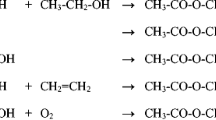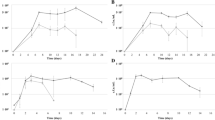Abstract
Isobutanol, isoamyl acetate and ethyl hexanoate production during winemaking fermentations was precisely described. Volatile compound concentrations and their rates of change and losses in the exhausted gas were determined throughout the fermentation. Negligible amounts of isobutanol were lost, whatever the fermentation temperature. In contrast, 56 % of the ethyl hexanoate and 34 % of the isoamyl acetate were stripped by CO2 when the temperature profile simulated red winemaking conditions. Even at a moderate temperature of 20 °C, typical of white wine fermentations, 40 % of the ethyl hexanoate and 21 % of the isoamyl acetate were lost. The effect of temperature on the production of the volatile compounds was assessed by running fermentations at different temperatures, with the same medium and strain. By taking into account the volatile compound losses in the exhausted gas, changes in volatile compound production were found to be smaller than those usually calculated from the concentrations in the wine. These findings highlight the potential importance of knowledge concerning aroma gas–liquid balances for both an understanding of yeast metabolism and the identification of innovative control strategies minimizing aroma losses.






Similar content being viewed by others
References
Athes, V., Paricaud, P., Ellaite, M., Souchon, I., & Furst, W. (2008). Vapour–liquid equilibria of aroma compounds in hydroalcoholic solutions: measurements with a recirculation method and modelling with the NRTL and COSMO-SAC approaches. Fluid Phase Equilibria, 265(1–2), 139–154.
Aznar, M., Tsachaki, M., Linforth, R. S. T., Ferreira, V., & Taylor, A. J. (2004). Headspace analysis of volatile organic compounds from ethanolic systems by direct APCI-MS. International Journal of Mass Spectrometry, 239, 17–25.
Beltran, G., Novo, M., Guillamon, J. M., Mas, A., & Rozes, N. (2008). Effect of fermentation temperature and culture media on the yeast lipid composition and wine volatile compounds. International Journal of Food Microbiology, 121(2), 169–177.
Bely, M., Sablayrolles, J.-M., & Barre, P. (1990). Description of alcoholic fermentation kinetics—its variability and significance. American Journal of Enology and Viticulture, 41(4), 319–324.
Conner, J. M., Birkmyre, L., Paterson, A., & Piggott, J. R. (1998). Headspace concentrations of ethyl esters at different alcoholic strengths. Journal of the Science of Food and Agriculture, 77, 121–126.
Cottrell, T. H. E., & Mc Lellan, M. R. (1986). The effect of fermentation temperature on chemical and sensory characteristics of wines from seven white grape cultivars grown in New York state. American Journal of Enology and Viticulture, 37(3), 190–194.
Escalona, H., Piggott, J. R., Conner, J. M., & Paterson, A. (1999). Effect of ethanol strength on the volatility of higher alcohols and aldehydes. Italian Journal of Food Science, 11, 241–248.
Ferreira, V., Pena, C., Escudero, A., & Cacho, J. (1996). Losses of volatile compounds during fermentation. Zeitschrift Fur Lebensmittel-Untersuchung Und-Forschung, 202(4), 318–323.
Francis, I. L., & Newton, J. L. (2005). Determining wine aroma from compositional data. Australian Journal of Grape and Wine Research, 11(2), 114–126.
Killian, E., & Ough, C. S. (1979). Fermentation esters—formation and retention as affected by fermentation temperature. American Journal of Enology and Viticulture, 30, 301–305.
Llaurado, J., Rozes, N., Bobet, R., Mas, A., & Constanti, M. (2002). Low temperature alcoholic fermentations in high sugar concentration grape musts. Journal of Food Science, 67(1), 268–273.
Meynier, A., Garillon, A., Lethuaut, L., & Genot, C. (2003). Partition of five aroma compounds between air and skim milk, anhydrous milk fat or full-fat cream. Le Lait, 83, 223–235.
Molina, A. M., Swiegers, J. H., Varela, C., Pretorius, I. S., & Agosin, E. (2007). Influence of wine fermentation temperature on the synthesis of yeast-derived volatile aroma compounds. Applied Microbiology and Biotechnology, 77(3), 675–687.
Morakul, S., Athes, V., Mouret, J.-R., & Sablayrolles, J.-M. (2010). Comprehensive study of the evolution of gas–liquid partitioning of aroma compounds during wine alcoholic fermentation. Journal of Agricultural and Food Chemistry, 58(18), 10219–10225.
Morakul, S., Mouret, J.-R., Nicolle, P., Trelea, I. C., Sablayrolles, J.-M., & Athes, V. (2011). Modelling of the gas–liquid partitioning of aroma compounds during wine alcoholic fermentation and prediction of aroma losses. Process Biochemistry, 46, 1125–1131.
Mouret J-R, Nicolle P, Angenieux M, Aguera E, Perez M & Sablayrolles J-M (2010). On-line measurement of 'quality markers' during winemaking fermentation. International Intervitis Interfructa Congress, Stuttgart, Germany.
Robinson, A. L., Ebeler, S. E., Heymann, H., Boss, P. K., Solomon, P. S., & Trengove, R. D. (2009). Interactions between wine volatile compounds and grape and wine matrix components influence aroma compound headspace partitioning. Journal of Agricultural and Food Chemistry, 57(21), 10313–10322.
Sablayrolles, J.-M., & Barre, P. (1993). Kinetics of alcoholic fermentation under anisothermal enological conditions. 1. Influence of temperature evolution on the instantaneous rate of fermentation. American Journal of Enology and Viticulture, 44(2), 127–133.
Sumby, K. M., Grbin, P. R., & Jiranek, V. (2010). Microbial modulation of aromatic esters in wine: current knowledge and future prospects. Food Chemistry, 121(1), 1–16.
Swiegers, J. H., Bartowsky, E. J., Henschke, P. A., & Pretorius, I. S. (2005). Yeast and bacterial modulation of wine aroma and flavour. Australian Journal of Grape and Wine Research, 11(2), 139–173.
Torija, M. J., Beltran, G., Novo, M., Poblet, M., Guillamon, J. M., Mas, A., & Rozes, N. (2003). Effects of fermentation temperature and Saccharomyces species on the cell fatty acid composition and presence of volatile compounds in wine. International Journal of Food Microbiology, 85(1–2), 127–136.
Tsachaki, M., Gady, A.-L., Kalopesas, M., Linforth, R. S. T., Athès, V., Marin, M., & Taylor, A. J. (2008). Effect of ethanol, temperature, and gas flow rate on volatile release from aqueous solutions under dynamic headspace dilution conditions. Journal of Agricultural and Food Chemistry, 56(13), 5308–5315.
Tsachaki, M., Linforth, R. S. T., & Taylor, A. J. (2009). Aroma release from wines under dynamic conditions. Journal of Agricultural and Food Chemistry, 57(15), 6976–6981.
Acknowledgments
The research generating these results was funded by the European Community Seventh Framework Program (FP7/2007-2013) under grant agreement CAFE no. KBBE-212754 (http://www.cafe-project.org).
Author information
Authors and Affiliations
Corresponding author
Rights and permissions
About this article
Cite this article
Morakul, S., Mouret, JR., Nicolle, P. et al. A Dynamic Analysis of Higher Alcohol and Ester Release During Winemaking Fermentations. Food Bioprocess Technol 6, 818–827 (2013). https://doi.org/10.1007/s11947-012-0827-4
Received:
Accepted:
Published:
Issue Date:
DOI: https://doi.org/10.1007/s11947-012-0827-4




